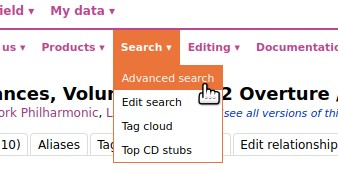Hello again, Budge:
Oh, I feel your pain!
The best way I have found to make this connection is using the physical CD, a CD-ROM drive, and MusicBrainz Picard. Put the CD in the drive. Point Picard at the drive. Picard reads the “table of contents” off the CD. That is essentially a list of the length of each track, in CD data units.
MusicBrainz reduces this table of contents to a string of letters and numbers, called a “disc ID”. For example, rozyacLbLL.1tAHHabvrkwrLkXY- describes a CD with 27 tracks, the first of which is 4 minutes 1 second long; the last of which is 1:08 long.
But if the physical CD happens to be put away in storage, then this approach is not helpful.
A second approach is to use the app, MusicBrainz Picard. Picard can do several things. One is that it can open your digital music files, sample the audio content, and look in a database for the MusicBrainz IDs of recordings with similar audio content. Picard then picks the most likely Release of these, and fetches its metadata from MusicBrainz.
This approach is great when it works. But the opera record business militates against it. When a major label records a well-known opera, they use and re-use bits of those recordings many times over. They may release the same full-length recording multiple times in different countries with different catalogue numbers. They may take just the popular bits and put them onto what I call a “ripped and bleeding chunks of music” CD (I believe this is not the official term). Your music file may be an audio match with all of these Releases.
When you ripped your CDs, did you save the .CUE file which the ripping software hopefully gave you? It has similar information to the CD table of contents. Picard has recently gained the ability to use CUE files, though I have not tried this myself. So maybe a third option might be, point Picard at CUE files, and it might look up the MusicBrainz entry as if you had the physical CD present.
Be sure to get all your search terms spelled right. I’ll bet your Così release was not on the HM label, which is related to “Hit Man Records”, and released the Italian Classics in Rock in 1997. You might instead mean French label Harmonia Mundi, with thousands of releases in its MusicBrainz listing.
That said, one tool that might help you is the MusicBrainz advanced query syntax for searches. The top two results for the search:
Cosi fan tutte Artist:"René Jacobs" Label:"Harmonia Mundi"
are:
- release/73e029e Così fan tutte, Harmonia Mundi 951663.65, a 1999 3-CD release by “Mozart; Véronique Gens, Bernarda Fink, Werner Güra, Marcel Boone, Pietro Spagnoli, Graciela Oddone, Concerto Köln, René Jacobs”.
- release/16e65f8 Così fan tutte, Harmonia Mundi HMC901663.65, a 1999 3-CD release by “Wolfgang Amadeus Mozart; Graciela Oddone, Pietro Spagnoli, Marcel Boone, Werner Güra, Bernarda Fink, Véronique Gens, Concerto Köln, René Jacobs”.
(There are 322,040 further results, which just goes to show, MusicBrainz doesn’t know when to stop.)
These two releases look similar but not identical. They have the same number of CDs and tracks, but the distribution of tracks to CDs differs: 22+18+17 tracks vs 22+17+18 tracks. They have different cover art and different catalogue numbers. Do either of these match the lengths and counts of the music files you have, and what you remember of the CD packaging?
Those are good questions, but they are different topics, so deserve different answers. The forum software gets impatient with me if I post too many answers in a row, so I will hold off on these other questions until a) they get posted each to their own topic, or b) others respond in this topic.
Budge, you are asking good questions! Please keep up the curiosity, and keep climbing with bleeding fingernails up the learning curve! You are poised to make excellent contributions to MusicBrainz.
Best regards,
—Jim DeLaHunt

